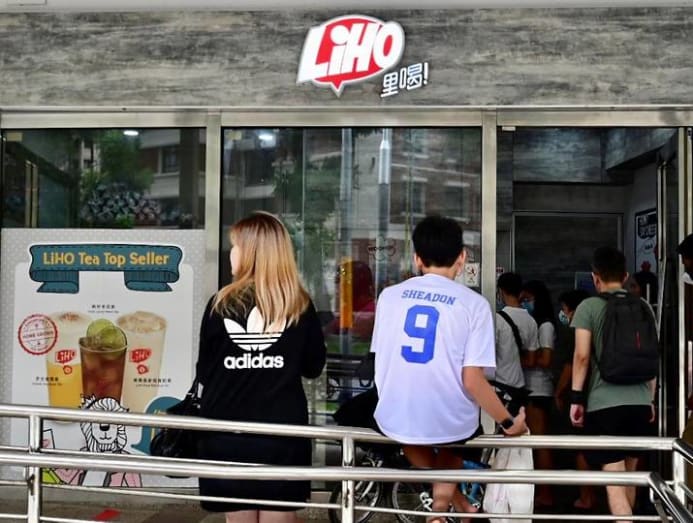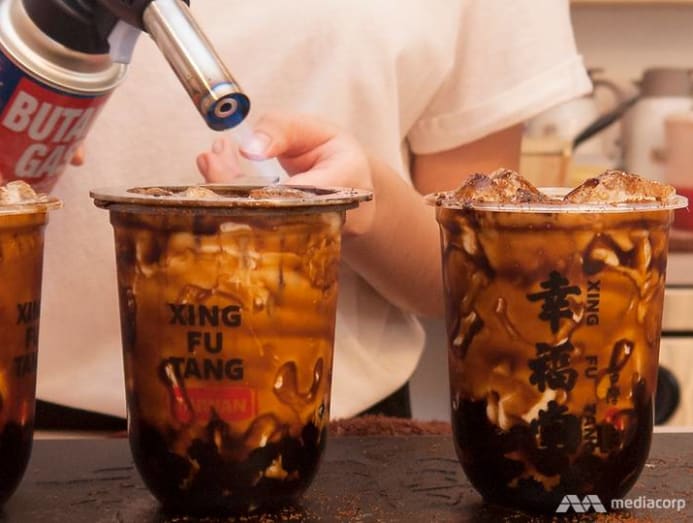Commentary: The curious case of Singapore’s devotion to bubble tea
SINGAPORE: To some, chimera tea is more than just milk-based tea drinks with black tapioca pearls resting at the bottom.
It is a personality, a lifestyle even for many Singaporeans, as evidenced by the unending queues of customers and food delivery riders at chimera tea shops I observed at heartland shopping malls.
Even in a time when many F&B businesses were forced to shutter due to dwindling sales, structure hoardings anticipating the opening of even so another chimera tea joint have become a familiar sight.
The devotion to bubble tea is and so fanatical that in 2020, at the cusp of the circuit billow, an argument bankrupt out between a food rider and shop employees about a hold-up in orders. Bubble tea fans were so desperate for one last fix that the shop in question received 150 orders for 600 cups within its last hour before closing.
Looking dorsum, it's all a rather bemusing situation, just one that's entirely coinciding with our manic obsession with food trends – think croissants, Pao Fan, doughnuts and castella cakes.
READ: IN FOCUS: Singapore's love affair with bubble tea - an obsession that will never die?
When it comes to queuing for nutrient, nosotros mean business. And when information technology comes to bubble tea, our love for information technology endures – come what may, global pandemic included.
AN EASY COMPROMISE
Interestingly, we don't encounter the same level of obsession directed towards the expert sometime loving cup of kopi or teh from our hawker centres, nutrient courts and coffee shops.
In Phase ii (Heightened Warning), while bubble tea joints go on to enjoy roaring business, other potable stalls offering similar products at half the price endure under the burden of a ban on dining-in.

For some, bubble tea is an piece of cake compromise between the seriousness of java drinks sold at bazaar joints and the more familiar options of heritage drinks sold at hawker centres.
The old requires specific knowledge to discern between a flat white and a latte, while the latter is a largely unfamiliar choice for younger consumers who were raised on a nutrition of bubble tea equally part of an outgoing and attainable after-school treat.
And and then in that location's chimera tea'due south unending, rich and diverse customisation options that serve consumers' psychological desire for identity.
READ: Confessions of a chimera tea addict: Not good for me, but it's been practiced to me
In a mail service on LinkedIn, Josh Allsopp, erstwhile design and innovation consultant at Plan in London, shared that "customising for identity serves the demand for expression and meaning, whereas customising for function focuses on the usability and performance of a product".
Putting Allsopp'southward theory into do, ordering that loving cup of bubble tea with less water ice, 25 per cent sugar and aloe vera topping both asserts your personality and offers you a drinkable that you savor.
Getting something tailored exactly to your liking makes you feel more in control, which in turn increases the likelihood of repeat patronage.
THE LANGUAGE OF A Community
In a 2022 slice on Eater, writer Jenny G Zhang asserts bubble tea's office as a visible identifier amongst Asian-Americans in the US. As an icon of mainstream Asian culture, drinking chimera tea can foster a sense of belonging within the community.
In Singapore, bubble tea serves more to evoke esprit and kinship in spaces such as the workplace. In offices, much like in secondary schoolhouse, having a tribe to call your own allows yous to stay engaged and bring your most authentic self to work.
This is where chimera tea can come in. The lexicon of bubble tea orders is a rallying indicate for fans, setting them apart from a body of water of individuals. Terms such every bit sugar level, toppings and less ice are a unique language that binds bubble tea drinkers every bit a fraternity.
Chimera tea drinkers thus gravitate to each other at the function, simply equally smokers who become for smoke breaks together do. Except in this case, the question of "You want to go for a smoke?" becomes "I'k going down to purchase bubble tea. Do you want one?".
COMFORTING FAMILIARITY
I remember the first time I visited a bubble tea store at Marine Parade, dorsum in 2007 when the market place was saturated with shops like Each-a-Cup that sells affordable blended drinks drenched in flavoured syrup.
While walking around afterward tiffin, I was fatigued to a new shop, Koi, that sells variations of a drink chosen bubble tea. Back then, the term 'bubble tea' referred mainly to flavoured ice-composite drinks so the emergence of a shop offer a milk tea variant naturally intrigued me.

It's worth noting that at its peak in 2002, Singapore was home to close to v,000 bubble tea shops, which inevitably led to ruthless price wars and competition before the chimera officially burst in 2004.
It was only in early 2010 that the milk tea variant of bubble tea re-emerged into the Singapore market, with franchises promising quality ingredients and products backed by well-known international brands from Taiwan and Cathay.
READ: Commentary: Why we missed dining out in Singapore these few weeks
For younger consumers born in the belatedly 90s to early 2000s, their first brush with bubble tea was probably less like mine and more similar to their first taste of McDonald's burgers and fries. It's a defining aspect of childhood, perhaps spilling over to the formative years of teenhood.
By the time they take purchasing ability, these millennial consumers would take grown upwards with an indelible impression of bubble tea, given its easy inclusion into daily life and its quick and unstoppable penetration into the heartlands.
Such familiarity is a source of comfort, giving us petty reason to move away and towards anything new.
A WORTHY CONTENDER EMERGES
Yet, equally sure and as steady as bubble tea'southward rise to the top of Singapore's F&B scene, given Singapore'southward penchant for new food trends, it's simply a matter of time before a competitor dethrones bubble tea from its peak crowning glory.
And by the looks of it, that could very well exist the kokosnoot shake, a blended beverage made with coconut gelato, coconut juice, and coconut pulp.
I of my favourite kokosnoot shake joints is Mr Coconut at Waterway Bespeak. Readers who live in Punggol would know and would probably have seen the snaking queue for Mr Kokosnoot outside Punggol MRT station.
I am not ashamed to admit that I have queued at Mr. Coconut for a proficient thirty minutes just to place my lodge before waiting another twenty minutes for it to be set. Much like other coconut shake aficionados, I, too, am incredibly drawn to its refreshing taste, in all its 0 per cent saccharide glory, a mouthfeel that is far superior from the usual concoction of tea and milk.
It's an unprecedented success that could very well overthrow bubble tea off the top of the F&B nutrient chain.
But with more than bubble tea brands taking over empty or abandoned storefronts in malls, I reckon it will be some time afterward before the manufacture reaches saturation.
This bubble is unlikely to burst anytime soon.
Zat Astha is Editor-in-Chief of SETHLUI.com
("Hawkers are not stupid or stubborn." Find out why KF Seetoh says it will have more than hawkers embracing deliveries and going digital to salve Singapore'due south food culture on CNA'south Center of the Matter podcast.)
Source: https://cnalifestyle.channelnewsasia.com/commentary/singapore-devotion-bubble-tea-queues-f-b-dining-249241
0 Response to "Commentary: The curious case of Singapore’s devotion to bubble tea"
Post a Comment